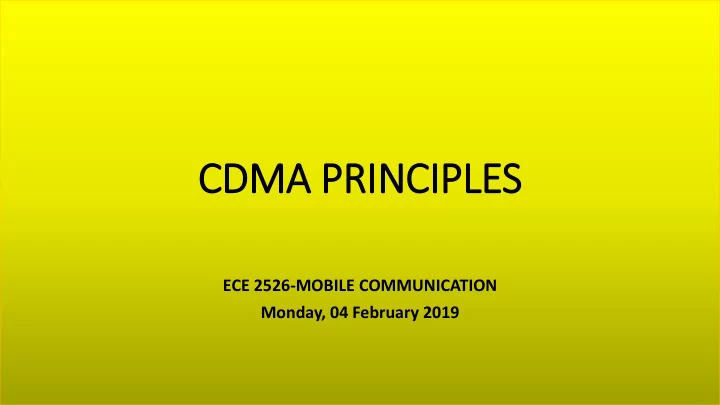

CDMA PRINCIPLES ECE 2526-MOBILE COMMUNICATION Monday, 04 February 2019
SAMSUNG DUOS SPECIFICATIONS
SECOND GENERATION TECHNOLOGIES 1 ST GENERATION 2 ND GENERATION FDMA/TDM-BASED SYSTEMS 1. GSM (European Standard) FDMA – BASED SYSTEMS 2. DAMPS/IS 136 - US Standard) 1. AMPS (US Standard) PDC – Personal Digital Service (Japanese 3. 2. ETACS (UK Standard) Standard) 3. NMT (Nordic Countries) CDMA 1. IS-95 - US Standard)
CODE DIVISION MULTIPLE ACCESS (CDMA) 1. Code Division Multiple Access (CDMA) also known as IS-95 is a spread spectrum technology platform that enables multiple users to occupy the same radio channel or frequency spectrum at the same time. 2. Each CDMA Mobile Station (MS) employs its own unique code to distinguish it from other MSs. 3. CDMA Offers users all features associated with spread spectrum communication which include: a) Ability to thwart interference b) Improved immunity to multipath effects c) Anti-jam
HISTORY OF CDMA • Motivation – Intended as a new system (greenfield) or replacement for AMPS (not an upgrade) to a) Increase system capacity b) Increase security c) Add new features/services • History: • 1990: Qualcomm proposed a code division multiple access (CDMA) digital cellular system claimed to increase capacity by factor 20 or more – Started debate about how CDMA should be implemented and the advantages vs. TDMA (religious tones to debate) • 1992: Telecommunication Industry Association (TIA) starts a study of spread spectrum cellular • 1995: First CDMA system (named CDMA-one) launched in Hongkong
TYPES OF CDMA SYSTEMS CDMA Narrow band Wide Band CDMA 2000 WCDMA/UMTS IS95B J-STD 008 IS95 ANSI Standard Launch date: 1999 Launch date: 1995 Published – 1996 Frequency Band: 800 Frequency Band: 800 MHz & 1900 MHz Frequency Band: Chip rate: 1,228,800 bits/s 800 & 1900 MHz Data rate: 115 Kbps Data rate: 14.4 Kbps
CDMA(IS-95) ARCHITECTURE (a) CDMA Architecture (b) GSM Architecture
CDMA MOBILE STATION Mobile Station Contains: Mobile Equipment (ME) 1. Subscribers Identity Module (SIM) 2.
FUNCTIONS OF THE CDMA BTS • It defines the cell . • It handles the radio link protocol with the mobile station
FUNCTIONS OF THE CDMA MSC 1. Call set up/supervision/release 2. Call routing 3. Billing information collection 4. Mobility management 5. Paging, connection to BSC, other MSC and other local exchange networks 6. Access to HLR and VLR
PROPERTIES/FUNCTIONS OF THE CDMA HLR 1. One HLR per CDMA operator 2. Contains permanent database of all the subscribers in the network 3. Contains MSRN(mobile station routing no.)
FUNCTIONS OF THE CDMA BSC 1. It manages radio resources for one or more BTS. 2. Allocation and Deallocation of channels. 3. Transmitter power control. 4. Handoff control BSC
COMPARISON OF FDM/TDM SYSTEMS & CDMA 1. In TDMA Bandwidth available per channel is small which leads to compromise in quality of transmission. Whereas in CDMA systems entire bandwidth is used which enhances voice quality. 2. In TDMA/FDMA, cell design requires more frequency planning which is tough job. Whereas in CDMA frequency planning is minimal. 3. TDMA is band-limited system while CDMA is power-limited system
FEATURES OF CDMA 1. Frequency reuse of one 2. Tight power control 3. Longer battery life 4. Support for soft handoff
ADVANTAGES OF CDMA 1. High capacity without hard blocking limits 2. Easy frequency planning 3. Greater coverage with fewer cells 4. Technology platform extendable to new services 5. Excellent call quality 6. Inherent privacy 7. Lower power/Longer battery life
DISADVANTAGES OF CDMA • Near far problem. • CDMA can not offer international roaming, a large GSM advantage
DIRECT SEQUENCE/PSEUDO NOISE TRANSMITTER – FROM REVIOUS CLASS • In Direct Sequence(also called a Pseudo-noise), the signal is generated by adding a binary message with the output of a pseudo-noise generator as shown below: Message Binary Balanced Adder Modulator Output Clock Pseudo-noise Carrier Generator 𝑔 𝑑
CDMA PRINCIPLE Rate of Change Known as bitrate Each bit of sequence 1 is replaced by the code sequence Message signal + Rate of Change Known as chiprate Output Pseudo Code
BASE STATIONS – PN SE SEQUENCIES, TIM TIMING • All base stations use same PN sequence • Each base station selects from 512 different PN off-sets • Mobile station synchronizes to a pilot channel • Each base station has GPS receiver to synchronize self with other bases stations • Timing accuracy is vital to CDMA system functionality
GSM SM AND CDMA LIN INK DESIGNATION (a) CDMA Um interface link designation (b) GSM um Interface Link designation
MOBILE STATION CODES 1. Channelized by digital codes called long codes masked by a unique user long code mask 2. Long code is a 42 bit number - 2 42 billion combinations 3. Each mobile has a different long code mask 4. Two types of reverse channels: a) Traffic channels b) Control/access channels
FORWARD CHANNELIZATIO ION Output Encoded Walsh coded voice XOR data data 1.2288 mcps Walsh code 1.2288 mcps generator Each bit of voice data is ‘spread’ by a factor of 64
REVERSE CH CHANNELIZATIO ION Walsh Output modulated Long coded XOR voice data data 1.2288 mcps Masked Long Code 1.2288 mcps Data
COMPARISON OF 2G TE TECHNOLOGIES Feature AMPS D-AMPS GSM CDMA Frequency Band 800 MHz 800 & 1900 MHz 900 & 1800 MHZ 800 & 1900 MHz Channel Width 30 KHz 30 KHz 200 KHz 1.25 MHz Users per 1 3 8 About 20 Channel Multiplex FDMA FDMA & TDMA FDMA & TDMA CDMA Scheme Network IS-41 IS-41 GSM-MAP IS-41 (MAP-Mobile Application Part) Architecture
Recommend
More recommend